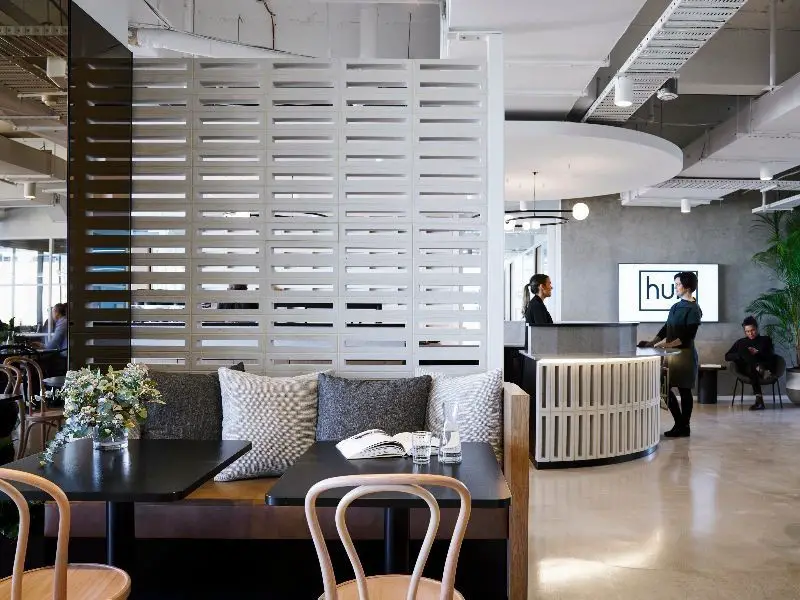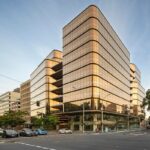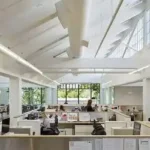Hub Parliament Station on Nicholson Street, East Melbourne Development, Australian Interior Architecture
Hub Parliament Station, East Melbourne News
Nicholson Street Building in Victoria design by Bates Smart Architects, Australia
16 July 2019
Hub Parliament Station on Nicholson Street, East Melbourne
Design: Bates Smart Architects
Orica House – formerly ICI House – was Australia’s first skyscraper.
Location: Nicholson Street, East Melbourne, Victoria, Australia
Bates Smart completes new co-working workplace fit-out at Hub Parliament Station
Hub lobby:
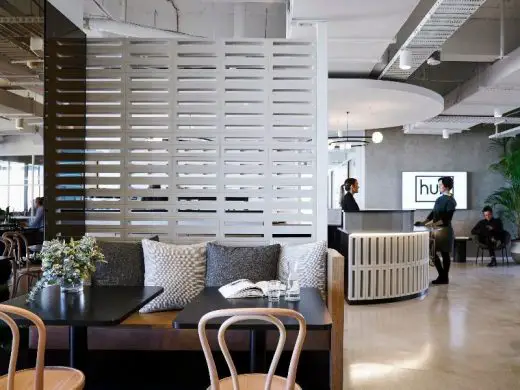
photo © Anson Smart
Bates Smart has delivered a next-generation premium co-working space with the completion of Hub Parliament Station on Nicholson Street, East Melbourne.
Spanning 2,775sqm, Bates Smart was engaged to design Hub Australia’s latest Melbourne venture, occupying the top three floors (levels 16 to 18) of the iconic ICI House, currently known as Orica House.
Originally designed by Bates Smart + McCutcheon in 1958, the new co-working space is embedded in the building that shares a 60-year-long history as Australia’s first skyscraper and redefined Melbourne’s skyline.
Bates Smart Director, Kellie Payne said “the new co-working space environment is designed to foster its community’s culture with a strong focus on hospitality while respecting the building’s historical significance.
“The original design of ICI House was the inspiration for Hub Parliament Station with its human-centric, forward-thinking approach to how people work.
“After six decades, the building still remains relevant today and surpasses modern wellbeing criteria as it is set to house the next evolution of working by welcoming Hub to its top floors,” says Payne.
The Hub Parliament Station interior is inspired by its base building’s mid-century classic design with a Palm Springs-like influence.
Hub interior:
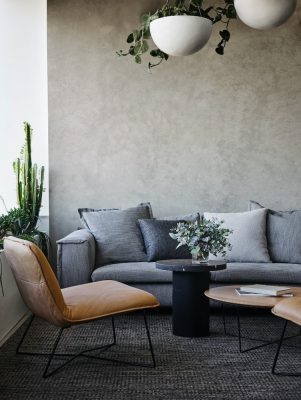
photo © Anson Smart
The surrounding parklands are brought within the interior with lushing planting throughout. All private member offices are positioned on the building perimeter, close to natural light with outward facing views to the parklands and city.
“The building is open and invites natural light with the most incredible views of Melbourne with aspects that overlooks the Parliament Gardens and the top-end of Spring Street, and the other over the Carlton Gardens with the Royal Exhibition Building in the background,” adds Payne.
Accommodating over 500 members, the new co-working space includes a café, integrated barista bar/hot desks, a boardroom, large serviced meeting rooms, private offices that can be open or screened, member kitchen and lounge, fitness centre, parent and wellness rooms and a media hub.
The work-zone spine runs centrally through each floor, made up of a series of flexible, open-plan workspaces, breakout zones and dedicated rooms. Each is tailored to suit the different workstyles of each business or individual.
“We identified five key ‘balances’ for Hub Australia which included how we addressed the balance between creativity, ownership, identify, disruption and brand.
“The design has been informed by a detailed analysis of Hub Australia’s member experiences, understanding their typical day, lifestyle and working behaviours. From their morning coffee, schedule of meetings with clients, interests in exercise or time for a mid-morning yoga session and need for a quieter environment to reply to emails,” said Payne.
Hub Australia CEO and Founder, Brad Krauskopf, said: “We’re proud to have partnered with the award-winning Bates Smart team to design Hub Australia’s first skyscraper co-working space in the iconic ICI House. We always look for unique buildings with a story and a history that our co-working members can then weave into their own, and Hub Parliament Station is an exciting new space which will deliver our members a premium co-working experience in an exceptional Melbourne CBD location.”
Hub meeting room:
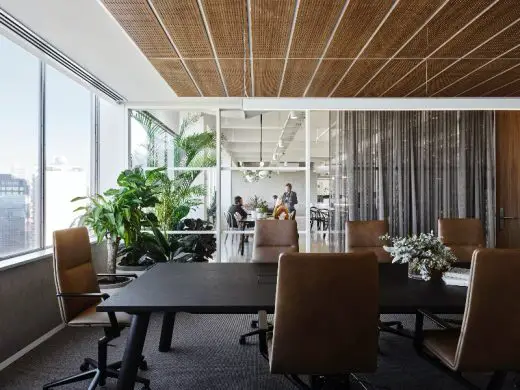
photo © Anson Smart
Hub Parliament Station’s interior design reference key mid-century notions including:
/ Authentic + Honest: form follows function, truth and modesty in building materials, an integrated design vision.
/ Organic + Geometric: pure geometric forms, complexity through detail, scale and repetition of simple forms.
/ Scale + Texture: relationship of hard and soft, the blending of interior and exterior materials, authentic application of materiality to celebrate beauty.
/ Light + Nature: maximising wellbeing by bringing the outside in, bold approach to planting and greenery, planting that frames a vista or view.
The planning was also informed by the base build architectural grid, to maximise efficiency across each floorplate.
Elements of the original documentation of the base building have been seamlessly incorporated within Hub Australia’s new workspace. Breezeblocks are used throughout, in screens, walls and joinery, referencing the existing concrete waffle slab and ground floor lobby brickwork.
ICI House Melbourne
About ICI House (1958), currently known as Orica House
ICI House celebrated its 60th birthday last year and at the time of its completion, was Australia’s first skyscraper.
ICI House, currently known as Orica House, is considered Australia’s first skyscraper. The building was the first to break Melbourne’s height restrictions, thereby setting a precedent for taller buildings within the city.
The freestanding, fully glazed curtain wall skyscraper, with its clearly demarcated lifts and services, is considered Bates, Smart & McCutcheon’s most refined building of the post-war period. The tower also symbolises Australia’s contribution to the Modernism movement, exemplified by overseas architects such as Skidmore, Owings & Merrill (SOM), Mies van der Rohe and Le Corbusier.
The 19-storey tower, not formally part of the CBD’s Hoddle Grid, was allowed to break the 40 metre height restrictions. The design cleverly determined the maximum yield of a 40 metre tower over the whole site, and then with council’s permission, redistributed this same yield into a tower form of 80 metres, thereby freeing up the ground plane for gardens. This approach signalled the start of plot ratio determinations for city sites and changed Melbourne’s planning regulations and skyline forever.
ICI House also signified a number of innovative advancements in construction techniques, including the use of concrete and pre-cast units in structural members and flooring. The original entry to the building was via the landscaped garden on Nicholson Street, which today still features the prominent fountain sculpture by Gerald Lewers.
Bates Smart’s Melbourne studio relocated to the building in 2001. The building received an Australian Institute of Architects Award for Enduring Architecture in 2013.
Hub Parliament Station on Nicholson Street, East Melbourne images / information received 150719 from Bates Smart
Location: Nicholson St, Melbourne, Victoria, Australia
New Melbourne Architecture
Contemporary Melbourne Architecture
New Melbourne Buildings : current, chronological list
Melbourne Architecture Tours by e-architect
, Melbourne, Victoria, Australia
Architects: Bates Smart
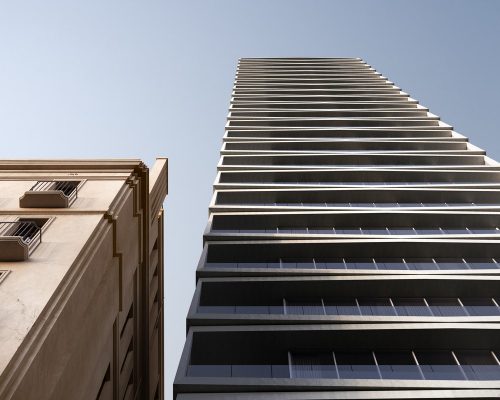
photo © Bates Smart
85 Spring Street Tower
New Moore Park Stadium, Driver Avenue, south-east Sydney, New South Wales, Australia
Architects: Bates Smart
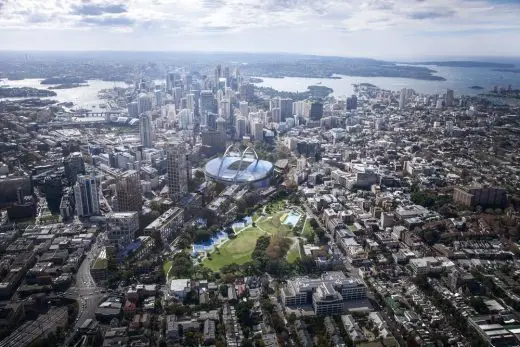
picture from Bates Smart
New Moore Park Stadium
Abode318 Apartments
Design: Elenberg Fraser
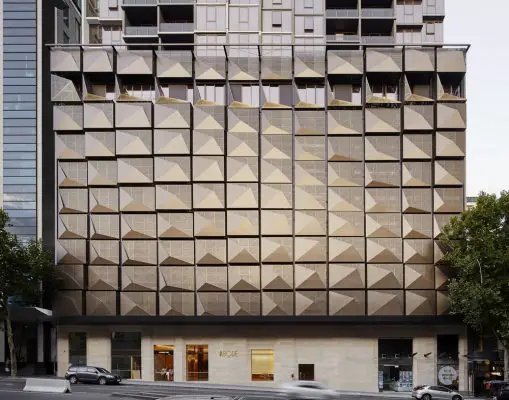
photo : Peter Clarke
Abode318 Apartments
VicRoads Office Building, Sunshine
Architects: Gray Puksand
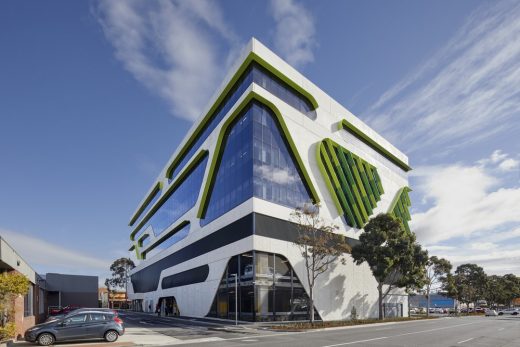
photo © Tatjana Plitt
VicRoads Office Building
Comments / photos for the Hub Parliament Station on Nicholson Street, East Melbourne – page welcome
Website: Middle Park, Melbourne

